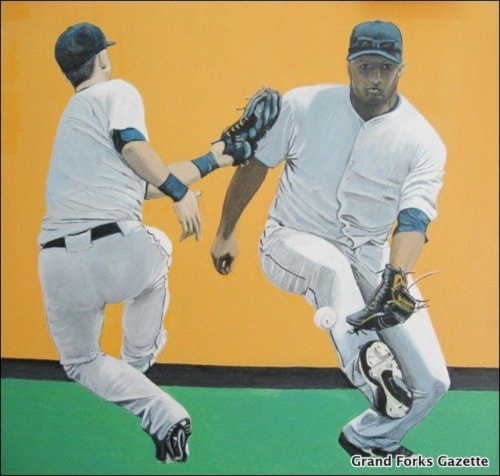Lesley McLaughlin: So, in the spirit of the Art Palette column, I’m here to have a conversation with local artist Jane Bradley about her painting, The Baseball Ballet, to find out from her what she would like to say about it.
Jane Bradley: OK. I’ve never been interviewed before. Feeling a bit self-conscious!
LM: Me, too. So, let’s begin with, is baseball a particular hobby of yours?
JB: No, not at all, sports in general are outside my frame of reference.
It’s another world, one I don’t know much about. However, I do enjoy painting people. Two golf scenes I painted for a Rivers’ Edge play began my foray into sports.
LM: So it was the human figure that was of interest to you.
JB: Very much so. I found this painting very interesting to do. The positions of the two figures are quite different from the poses a model could hold in our Monday evening drawing/painting sessions.
Caught in action and with the similarity of that action, there is the quality of mirroring each other in a dance and I liked that.
LM: Would you describe your style here as illustrative or realistic?
JB: I believe it’s realism. I sometimes get the sense that realism is a poor second cousin to abstract.
The definition of realism in my dictionary says the following: ‘The practice of regarding things in their true nature and dealing with them as they are with freedom from prejudice and convention’ and ‘Fidelity of representation, truth to nature, insistence upon details.’ I do enjoy the details and I love the idea of freedom from prejudice and convention. And I like the feeling that I’m sculpting with paint.
LM: The love of details does seem to reduce the ‘painterly’ effect, making the finished image more like a photograph. However, it does seem to me to permit the contrasts of light and shade to be subtly possible.
JB; Yes, I think the contrasts are what I enjoy in painting fabric and clothing where wrinkles and folds abound.
LM: What would you like the viewer to receive from this painting?
JB: I’d rather leave that to the viewer. I think everything has a particular beauty, its own humour and grace. Taking a blank canvas and creating something from nothing is very satisfying to me. Sculptors, carvers and potters must have similar joy in bringing life to a hunk of wood or a lump of clay creating something that wasn’t visible before.
LM: What would you like to receive from the viewer?
JB: What a wonderful question. I would really like a viewer to share their thoughts, whatever they are. No information runs the risk of filling the silence with one’s own self doubts. The potential for engagement is so often missed. Perhaps that is part of being a starving artist. It’s like there are three processes in producing a painting: first, the idea for a painting, then the execution of the vision, both exciting but somewhat solitary practices. The last process would be the sharing of the painting, where the potential to engage with another is possible.
LM: How would people do that in this instance?
JB: They could send their comments to Artpalette@hotmail.ca, or in a letter to the Gazette, or even directly to janebrad@telus.net
LM: Obviously we could continue this discussion, but we require to stay within the 400 words limit.
JB: I found being interviewed to be a uniquely interesting experience and enjoyable. I hope other artists would like to try this. Thank you.
The Art Palette is an open forum for discussion about art. Please contact us at artpalette@hotmail.ca with feedback on what you read here or to let us know your thoughts on anything art.
